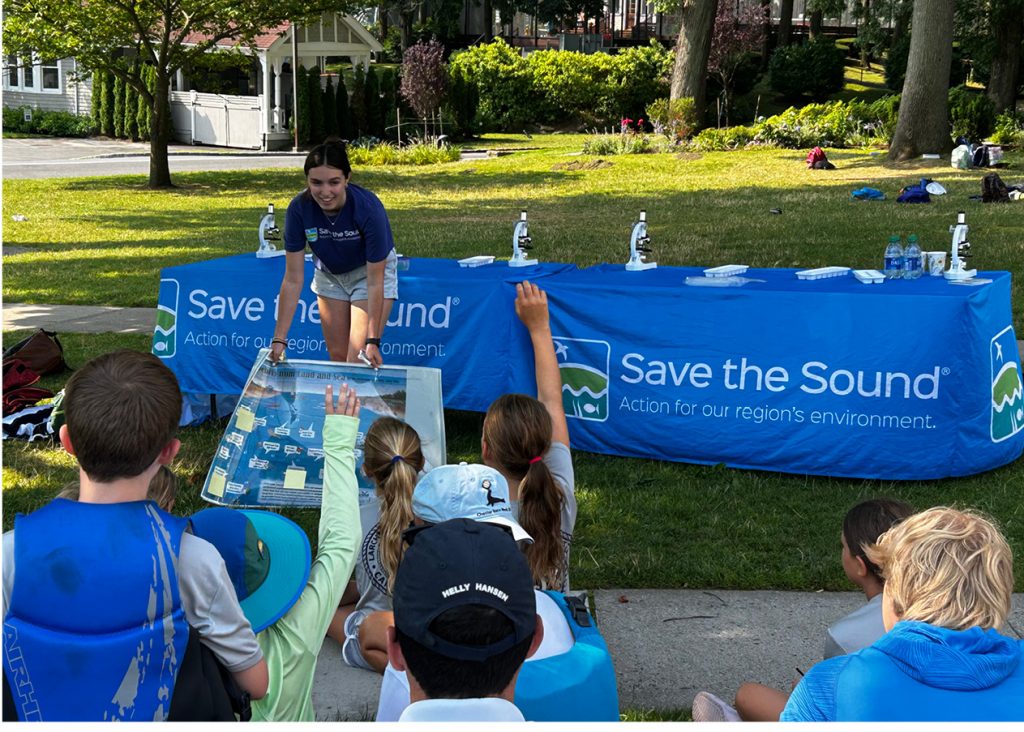Having grown up sailing on Long Island Sound, Tricia Leicht has always felt sailors should work to protect “their local playground.” A former board chair with the Junior Sailing Association of Long Island Sound (JSA) and now working for Save the Sound, she reached out to the JSA to see if they were interested. Current board chair Tim Clark was eager to partner the organizations and bring environmental programming to young sailors. The program became known as “Sound Advocates.”

Save the Sound intern Serena Finger leads an interactive Sound Advocates lesson. © Erin Wojdoszka
Save the Sound (STS) is a local environmental non-profit focused on protecting Long Island Sound. STS fish biologist Jon Vander Werff and ecological restoration experts worked this spring to develop a field-based program that would engage young sailors. And they succeeded. The program ran twenty-one sessions between June 27 and August 2 for over 400 children. Each 2-hour session was led by intern Serena Finger. Currently an Environmental Science major at George Washington, Serena also had experience teaching young children. “Serena was a perfect fit, and did an excellent job offering the environmental activities and keeping the sailors engaged,” said Tricia Leicht.
It was important to the Save the Sound team that the program not feel like school work, and they hit the target. Sound. Advocates incorporates sailing with learning about water and the local environment. It teaches young sailors about the Sound, environmental awareness, and how to make a difference through personal choices.
Serena said, “Once we started in June signups started off slowly, then all of sudden at the beginning of July, we were flooded with sailing programs requesting dates. It was amazing to see how many programs were interested in what we could teach their sailors.” Each session, Serena would arrive at the junior program and set up her table and equipment. She would then begin, “Have you ever wondered how the environment affects our local waterways? She introduced the lesson to the sailors and then they would move to the dock and get started with interactive labs. The sailors worked with Secchi Disks to measure water transparency, talked about storm runoff and its effects, tested the water for various minerals, used plankton tows, and looked at their findings under microscopes.
A plankton tow is a net and a bottle used for gathering water samples. The sailors used the samples to see what’s happening in our waters by looking at their findings using a microscope. Serena instructed them about the parts of the microscope and how to use it. The sailors took small samples of water and placed them on their slides to look under the microscope. At the session at Riverside Yacht Club, a young sailor named Charlie said, “Look! There is something swimming in here. Can you help me get it on my slide?” Charlie, a few other sailors and one of the coaches all gathered around to take a look at the plankton swimming in the sample.
Once they were finished, Serena would conclude the lesson by reviewing what they saw and how they can help keep our waters clean. Each sailor went home with a certificate designating them an official Advocate for Save the Sound! Tim Clark noted, “Raising awareness of our marine environment is not an effort that can be done in just one summer. The JSA is pleased with the early impact Sound Advocates has demonstrated in this first year, and looks forward to continuing to build on this success in the coming years in partnership with Save the Sound.”
For more information on Save the Sound or the Sound Advocates program, contact Tricia Leicht at tleicht@savethesound.org. ■




